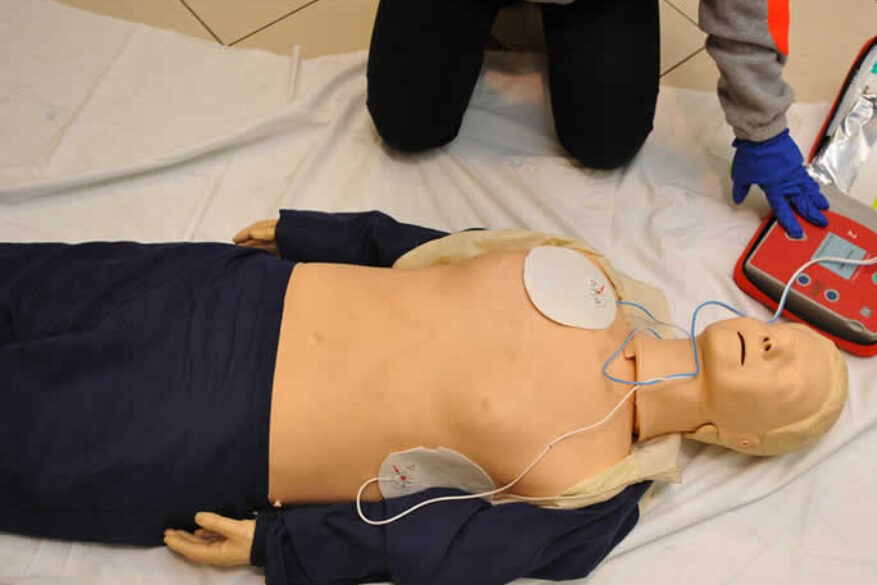
Who can use the defibrillator? Some information for citizens
The defibrillator is an instrument that can save a person in cardiac arrest. But who can use it? What does the law and the criminal code say? Obviously, the laws vary from country to country, but in principle the ‘Good Samaritan rule’, or its equivalent, applies in many of them
How serious is a cardiac arrest?
By now, defibrillators are being seen more and more, and in our daily lives we pass, almost without realising it, the defibrillator in pharmacies, gymnasiums, town halls and even train stations.
FIRST AID: VISIT THE DMC DINAS MEDICAL CONSULTANTS BOOTH AT EMERGENCY EXPO
Some people know that they are useful in the event of a cardiac arrest, but who can actually use a defibrillator?
One is generally led to believe that if you are not a doctor, while waiting for the ambulance it is better not to intervene, to do the bare minimum to avoid making the situation worse.
While this may be true in many cases, it is certainly not true with cardiac arrest.
Cardiac arrest is an extreme emergency situation, comparable in severity to drowning.
The pumping function of the heart suddenly ceases and as a result, the blood no longer circulates and cannot be oxygenated.
After the first few minutes in which the organs consume the oxygen present in the body, no longer receiving blood and oxygen, they all die.
In particular, the brain is the organ most sensitive to oxygen deficiency (called cerebral hypoxia) and already after less than 5 minutes suffers the first irreversible damage.
After 12 minutes, the brain is totally compromised and the chances of survival of the patient suffering from cardiac arrest are zero.
This is why immediate life-saving intervention is essential.
What is the defibrillator for?
Now that the severity of a cardiac arrest is clearer to us, we can understand why the AED (automated external defibrillator) is considered a life-saving tool.
The semi-automatic defibrillator is capable of automatically recognising the heart rhythm and indicating whether or not defibrillation is necessary.
Simply apply the electrodes to the chest and switch on the defibrillator.
This then automatically gives the rescuer voice instructions on when and how to act.
After analysing the heart rhythm, only if necessary, the defibrillator instructs the rescuer to press the button to deliver the electric shock to the heart (an electric shock, capable of restarting a heart in cardiac arrest).
The defibrillator will only deliver the shock in the presence of a shockable rhythm.
WOULD YOU LIKE TO GET TO KNOW RADIOEMS? VISIT THE RADIOEMS RESCUE BOOTH AT EMERGENCY EXPO
Who can use the defibrillator?
In Italy Law No. 116 of 4 August 2021 is a revolution in the field of defibrillators.
Among other things, it states that in cases of suspected cardiac arrest, and in the absence of trained medical or non-medical personnel, even a non-trained person is allowed to use the semi-automatic or automatic defibrillator.
The law refers to Article 54 of the Criminal Code, which states that actions taken by a person acting in a state of necessity in an attempt to render assistance and save a person in grave danger, such as cardiac arrest, are not punishable.
In detail, Article 54 ‘applies to a person who, not being in possession of the aforementioned requirements (a person who has received specific training), in an attempt to render assistance to a victim of suspected cardiac arrest, uses a defibrillator or performs cardiopulmonary resuscitation,’ Article 3 of the 2021 Act states.
In the event that a person has not taken the BLSD course, it will be the operators of the emergency number call centre who will guide them in performing cardiac massage, and if present nearby, in using the defibrillator, while waiting for help to arrive.
This is because only failure to use an AED defibrillator in the first few minutes can prevent a victim of sudden cardiac arrest from saving himself!
Read Also
Emergency Live Even More…Live: Download The New Free App Of Your Newspaper For IOS And Android
Defibrillator Maintenance: What To Do To Comply
Defibrillators: What Is The Right Position For AED Pads?
When To Use The Defibrillator? Let’s Discover The Shockable Rhythms
What Is The Difference Between Pacemaker And Subcutaneous Defibrillator?
What Is An Implantable Defibrillator (ICD)?
What Is A Cardioverter? Implantable Defibrillator Overview
Paediatric Pacemaker: Functions And Peculiarities
Cardiac Arrest: Why Is Airway Management Important During CPR?
RSV (Respiratory Syncytial Virus) Surge Serves As Reminder For Proper Airway Management In Children
Supplemental Oxygen: Cylinders And Ventilation Supports In The USA
Heart Disease: What Is Cardiomyopathy?
Inflammations Of The Heart: Myocarditis, Infective Endocarditis And Pericarditis
Heart Murmurs: What It Is And When To Be Concerned
Broken Heart Syndrome Is On The Rise: We Know Takotsubo Cardiomyopathy
Cardiomyopathies: What They Are And What Are The Treatments
Alcoholic And Arrhythmogenic Right Ventricular Cardiomyopathy
Difference Between Spontaneous, Electrical And Pharmacological Cardioversion
What Is Takotsubo Cardiomyopathy (Broken Heart Syndrome)?
Dilated Cardiomyopathy: What It Is, What Causes It And How It Is Treated
Heart Pacemaker: How Does It Work?
Italy, ‘Good Samaritan Law’ Approved: ‘Non-Punishability’ For Anyone Using A Defibrillator AED
Oxygen Damaging For Heart Attack Patients, Study Says
European Resuscitation Council (ERC), The 2021 Guidelines: BLS – Basic Life Support
Paediatric Implantable Cardioverter Defibrillator (ICD): What Differences And Peculiarities?


